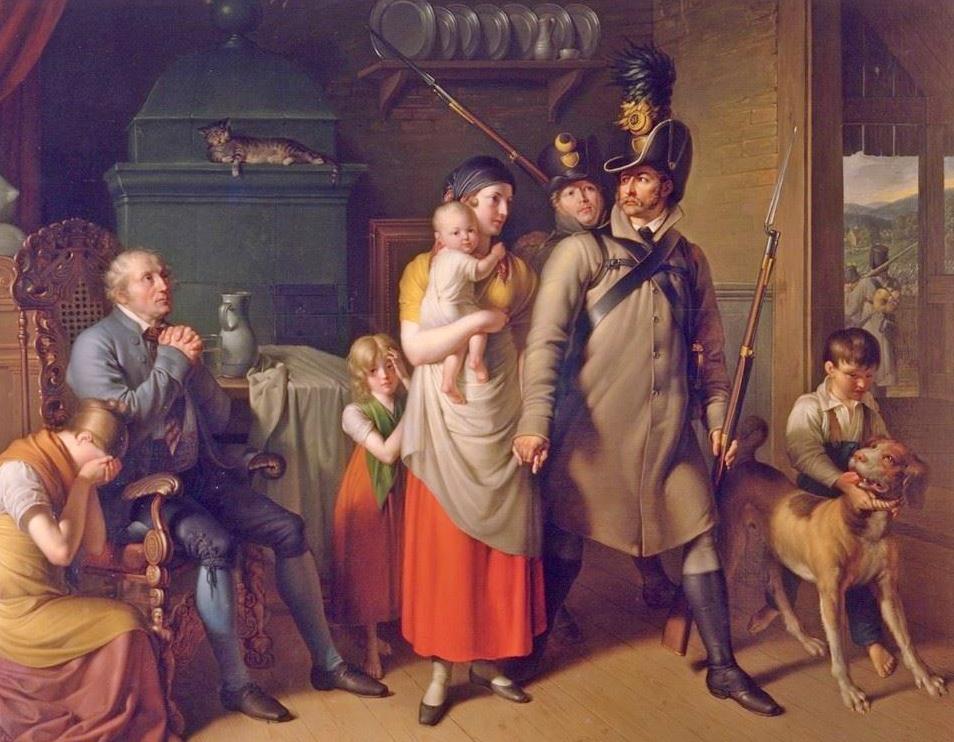
The Napoleonic War Campaigns: Struggle for Germany (1813)

Figure 1.--Agter the disaster in Russia (1812), Napoleon prepared for a struggle to maintain his hold on Germany. Prussia rose up in defiance. Austria had been the primary land power resisting Napoleon. But after so many defeats and with an Austrian princess married to Napoleon, Austria as the struggle for Germany shaped up hesitated, before joining the struggle. Artist Johann Peter Krafft was born in Hanau, Hesse (1780). He spent most of his life in Austria and supported the Hapsburg monrchy. Here we have his painting 'The soldier's farewell' (1813). It was painted at the time that the climatic German battles in the Napoleonic Wars were being fought.
|
|
The focus of the War after Napoleon's disaster in Russia passed to Germany. The image of the French had significantly changed. They was no longer even the pretense of the revolutionary republican force seeking to liberate the people of Europe from oppressive monarchies. France was now seen as a empire seeking to subgegate Germany. As in Spain, the Germans began to view the struggle against Napoleon and the French as a national war of liberation. German volunteers flocked to join the Prussian Army, but Austria at first held back. The French Army now confronting the Germans was a very differnt force. The debiliating campaigns of the Iberian Peninsula and the dissaster in Russia had cost much of the experienced core of the French army. Horses for the calvary were in short supply. Napoleon had to rely on inexperienced, poorly trained youths with very limited calvary to support them. This force confronted a powerful coalition of Britain, Prussia, Portugal, Russia, Spain, and Sweden. Evcen so, Napoleon began the campaign, despite the Russian campaign, with a subtanial force. He mustered some 400,000 men, a number not greatly different from the forces of the allies arrayed against him. These forces, however, gradully ground down the French. Austria at first hesitated, but was the key to the Allied victory. Austria had not confronted Napoleon since 1809 and had rebuilt their army. The Austrian Army under Schwartzenberg spearheaded the 1813 battles in Germany, but Bernadotte (Sweden) and Blücher (Prussia) played ley roles. Napoleon prevailed at Lutzen, Bautzen and Dresden, but they were not the crushing victories he needed and his losses were substantial. Badly outnumbered, he was finally crushed in a devestating 3-day battle at Leipzig and retired to France (October 1813). A major impact of the struggle was that the Germans began thinking about unification.
Sources
CIH

Navigate the Children in History Website:
[Return to Main Napoleonic war page]
[Return to Main 19th century wars page]
[Return to Main Austrian art page]
[Return to Main military style page]
[About Us]
[Introduction]
[Biographies]
[Chronology]
[Climatology]
[Clothing]
[Disease and Health]
[Economics]
[Freedom]
[Geography]
[History]
[Human Nature]
[Ideology]
[Law]
[Nationalism]
[Presidents]
[Religion]
[Royalty]
[Science]
[Social Class]
[Bibliographies]
[Contributions]
[FAQs]
[Glossaries]
[Images]
[Links]
[Registration]
[Tools]
[Children in History Home]
Created: 8:56 AM 11/26/2016
Last updated: 8:56 AM 11/26/2016



